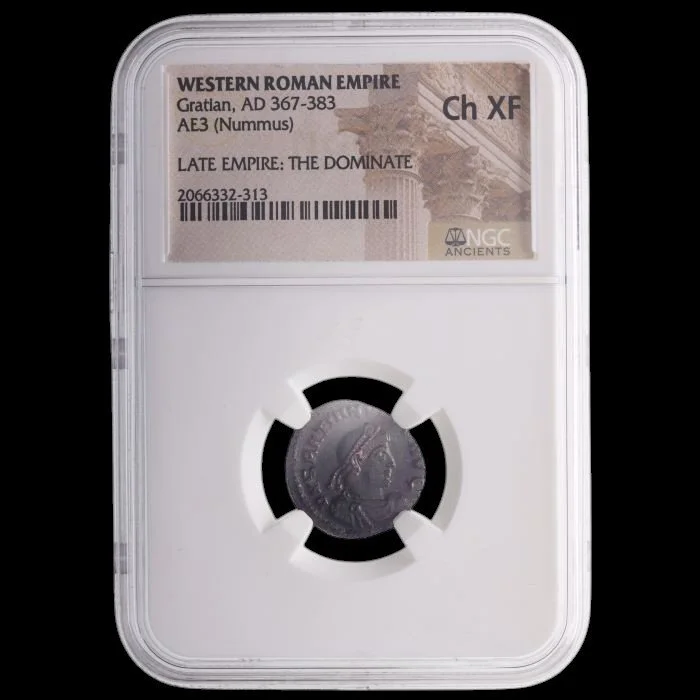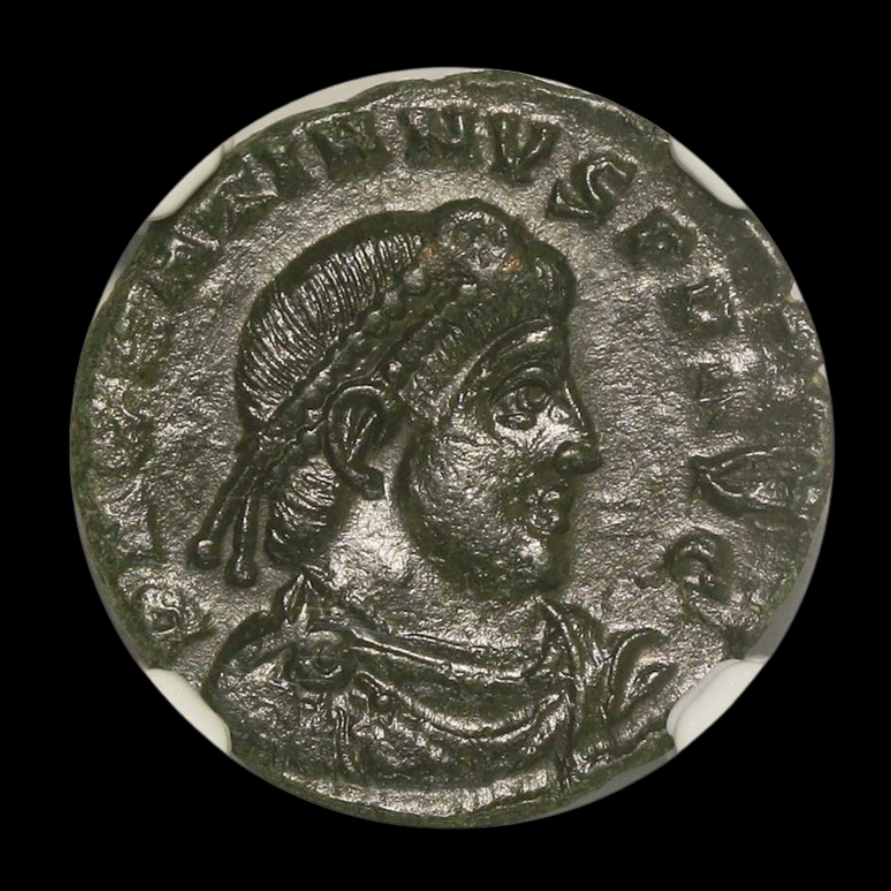 Image 1 of 7
Image 1 of 7

 Image 2 of 7
Image 2 of 7

 Image 3 of 7
Image 3 of 7

 Image 4 of 7
Image 4 of 7

 Image 5 of 7
Image 5 of 7

 Image 6 of 7
Image 6 of 7

 Image 7 of 7
Image 7 of 7








Roman Bronze AE3 of Gratian (about 1,642-1,658 years ago)
The coins shown are representative examples of the grade and type, but not the actual specimens for sale. For details on NGC’s grading standards and definitions, please refer to our NGC Grading page.
This bronze coin is an AE3 denomination issued during the reign of Emperor Gratian, who ruled the Western Roman Empire from 367 to 383 CE. As the son of Emperor Valentinian I, Gratian came to power at a young age during a period of increasing external pressure on Roman frontiers.
Coin Description:
Front side: Portrait of Emperor Gratian facing right, wearing a pearl diadem and imperial robes, with his name and titles in Latin around the edge.
Back side: Likely features common late Roman imagery such as the emperor standing with military standards, Victory crowning the emperor, or possibly a military-themed design reflecting his reputation as a warrior.
Technical Details:
Bronze alloy composition
Denomination: AE3 (medium-sized bronze coin in the late Roman monetary system)
Weight: Approximately 2-3 grams
Diameter: Approximately 18-20 mm
NGC Certified for authentication and preservation
Minted between 367-383 CE
Condition as specified by NGC certification
Historical Significance: Gratian ascended to the Western imperial throne in 375 CE following his father's death, though he had been co-emperor since 367 CE. The early years of his reign were characterized by military success and energetic leadership, with Gratian developing a reputation as an effective battlefield commander. In a critical decision, he appointed the Spanish general Theodosius I as Eastern Emperor following the disastrous Battle of Adrianople where his uncle Valens was killed fighting Gothic forces. Gratian's religious policies favored Orthodox Christianity over both paganism and Arianism, including removing the Altar of Victory from the Roman Senate House. His power began to wane when troops in Britain declared Magnus Maximus emperor, and Gratian was eventually assassinated in 383 CE. This coin represents an important transitional period that set the stage for Theodosius I's eventual reunification of the empire for the final time.
The coins shown are representative examples of the grade and type, but not the actual specimens for sale. For details on NGC’s grading standards and definitions, please refer to our NGC Grading page.
This bronze coin is an AE3 denomination issued during the reign of Emperor Gratian, who ruled the Western Roman Empire from 367 to 383 CE. As the son of Emperor Valentinian I, Gratian came to power at a young age during a period of increasing external pressure on Roman frontiers.
Coin Description:
Front side: Portrait of Emperor Gratian facing right, wearing a pearl diadem and imperial robes, with his name and titles in Latin around the edge.
Back side: Likely features common late Roman imagery such as the emperor standing with military standards, Victory crowning the emperor, or possibly a military-themed design reflecting his reputation as a warrior.
Technical Details:
Bronze alloy composition
Denomination: AE3 (medium-sized bronze coin in the late Roman monetary system)
Weight: Approximately 2-3 grams
Diameter: Approximately 18-20 mm
NGC Certified for authentication and preservation
Minted between 367-383 CE
Condition as specified by NGC certification
Historical Significance: Gratian ascended to the Western imperial throne in 375 CE following his father's death, though he had been co-emperor since 367 CE. The early years of his reign were characterized by military success and energetic leadership, with Gratian developing a reputation as an effective battlefield commander. In a critical decision, he appointed the Spanish general Theodosius I as Eastern Emperor following the disastrous Battle of Adrianople where his uncle Valens was killed fighting Gothic forces. Gratian's religious policies favored Orthodox Christianity over both paganism and Arianism, including removing the Altar of Victory from the Roman Senate House. His power began to wane when troops in Britain declared Magnus Maximus emperor, and Gratian was eventually assassinated in 383 CE. This coin represents an important transitional period that set the stage for Theodosius I's eventual reunification of the empire for the final time.



























